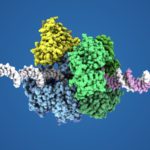Lien vers Pubmed [PMID] – 30647142
Lien DOI – 10.1042/BST20180579
Biochem Soc Trans 2019 02; 47(1): 239-249
Replicative DNA polymerases are nano-machines essential to life, which have evolved the ability to copy the genome with high fidelity and high processivity. In contrast with cellular transcriptases and ribosome machines, which evolved by accretion of complexity from a conserved catalytic core, no replicative DNA polymerase is universally conserved. Strikingly, four different families of DNA polymerases have evolved to perform DNA replication in the three domains of life. In Bacteria, the genome is replicated by DNA polymerases belonging to the A- and C-families. In Eukarya, genomic DNA is copied mainly by three distinct replicative DNA polymerases, Polα, Polδ, and Polε, which all belong to the B-family. Matters are more complicated in Archaea, which contain an unusual D-family DNA polymerase (PolD) in addition to PolB, a B-family replicative DNA polymerase that is homologous to the eukaryotic ones. PolD is a heterodimeric DNA polymerase present in all Archaea discovered so far, except Crenarchaea. While PolD is an essential replicative DNA polymerase, it is often underrepresented in the literature when the diversity of DNA polymerases is discussed. Recent structural studies have shown that the structures of both polymerase and proofreading active sites of PolD differ from other structurally characterized DNA polymerases, thereby extending the repertoire of folds known to perform DNA replication. This review aims to provide an updated structural classification of all replicative DNAPs and discuss their evolutionary relationships, both regarding the DNA polymerase and proofreading active sites.


